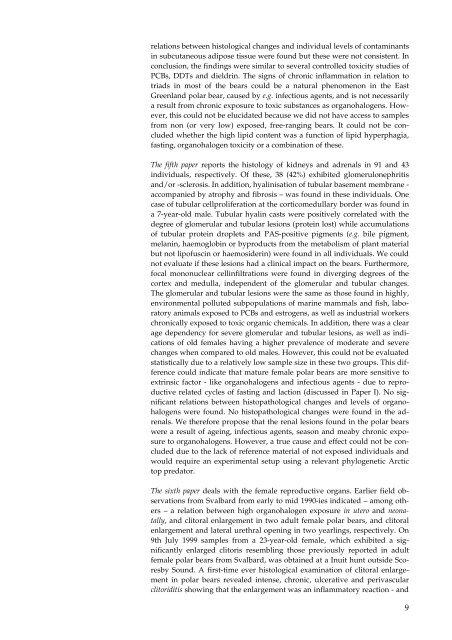Organohalogen concentrations and a gross and histologic ...
Organohalogen concentrations and a gross and histologic ...
Organohalogen concentrations and a gross and histologic ...
You also want an ePaper? Increase the reach of your titles
YUMPU automatically turns print PDFs into web optimized ePapers that Google loves.
elations between <strong>histologic</strong>al changes <strong>and</strong> individual levels of contaminants<br />
in subcutaneous adipose tissue were found but these were not consistent. In<br />
conclusion, the findings were similar to several controlled toxicity studies of<br />
PCBs, DDTs <strong>and</strong> dieldrin. The signs of chronic inflammation in relation to<br />
triads in most of the bears could be a natural phenomenon in the East<br />
Greenl<strong>and</strong> polar bear, caused by e.g. infectious agents, <strong>and</strong> is not necessarily<br />
a result from chronic exposure to toxic substances as organohalogens. However,<br />
this could not be elucidated because we did not have access to samples<br />
from non (or very low) exposed, free-ranging bears. It could not be concluded<br />
whether the high lipid content was a function of lipid hyperphagia,<br />
fasting, organohalogen toxicity or a combination of these.<br />
The fifth paper reports the histology of kidneys <strong>and</strong> adrenals in 91 <strong>and</strong> 43<br />
individuals, respectively. Of these, 38 (42%) exhibited glomerulonephritis<br />
<strong>and</strong>/or -sclerosis. In addition, hyalinisation of tubular basement membrane -<br />
accompanied by atrophy <strong>and</strong> fibrosis – was found in these individuals. One<br />
case of tubular cellproliferation at the corticomedullary border was found in<br />
a 7-year-old male. Tubular hyalin casts were positively correlated with the<br />
degree of glomerular <strong>and</strong> tubular lesions (protein lost) while accumulations<br />
of tubular protein droplets <strong>and</strong> PAS-positive pigments (e.g. bile pigment,<br />
melanin, haemoglobin or byproducts from the metabolism of plant material<br />
but not lipofuscin or haemosiderin) were found in all individuals. We could<br />
not evaluate if these lesions had a clinical impact on the bears. Furthermore,<br />
focal mononuclear cellinfiltrations were found in diverging degrees of the<br />
cortex <strong>and</strong> medulla, independent of the glomerular <strong>and</strong> tubular changes.<br />
The glomerular <strong>and</strong> tubular lesions were the same as those found in highly,<br />
environmental polluted subpopulations of marine mammals <strong>and</strong> fish, laboratory<br />
animals exposed to PCBs <strong>and</strong> estrogens, as well as industrial workers<br />
chronically exposed to toxic organic chemicals. In addition, there was a clear<br />
age dependency for severe glomerular <strong>and</strong> tubular lesions, as well as indications<br />
of old females having a higher prevalence of moderate <strong>and</strong> severe<br />
changes when compared to old males. However, this could not be evaluated<br />
statistically due to a relatively low sample size in these two groups. This difference<br />
could indicate that mature female polar bears are more sensitive to<br />
extrinsic factor - like organohalogens <strong>and</strong> infectious agents - due to reproductive<br />
related cycles of fasting <strong>and</strong> laction (discussed in Paper I). No significant<br />
relations between histopathological changes <strong>and</strong> levels of organohalogens<br />
were found. No histopathological changes were found in the adrenals.<br />
We therefore propose that the renal lesions found in the polar bears<br />
were a result of ageing, infectious agents, season <strong>and</strong> meaby chronic exposure<br />
to organohalogens. However, a true cause <strong>and</strong> effect could not be concluded<br />
due to the lack of reference material of not exposed individuals <strong>and</strong><br />
would require an experimental setup using a relevant phylogenetic Arctic<br />
top predator.<br />
The sixth paper deals with the female reproductive organs. Earlier field observations<br />
from Svalbard from early to mid 1990-ies indicated – among others<br />
– a relation between high organohalogen exposure in utero <strong>and</strong> neonatally,<br />
<strong>and</strong> clitoral enlargement in two adult female polar bears, <strong>and</strong> clitoral<br />
enlargement <strong>and</strong> lateral urethral opening in two yearlings, respectively. On<br />
9th July 1999 samples from a 23-year-old female, which exhibited a significantly<br />
enlarged clitoris resembling those previously reported in adult<br />
female polar bears from Svalbard, was obtained at a Inuit hunt outside Scoresby<br />
Sound. A first-time ever <strong>histologic</strong>al examination of clitoral enlargement<br />
in polar bears revealed intense, chronic, ulcerative <strong>and</strong> perivascular<br />
clitoriditis showing that the enlargement was an inflammatory reaction - <strong>and</strong><br />
9

















